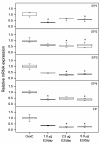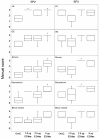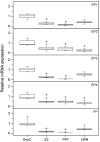Prostaglandin receptors EP and FP are regulated by estradiol and progesterone in the uterus of ovariectomized rats
- PMID: 22257560
- PMCID: PMC3278370
- DOI: 10.1186/1477-7827-10-3
Prostaglandin receptors EP and FP are regulated by estradiol and progesterone in the uterus of ovariectomized rats
Abstract
Background: Prostaglandins are important for female reproduction. Prostaglandin-E2 acts via four different receptor subtypes, EP1, EP2, EP3 and EP4 whereas prostaglandin-F2alpha acts through FP. The functions of prostaglandins depend on the expression of their receptors in different uterine cell types. Our aim was to investigate the expression of EPs and FP in rat uterus and to identify the regulation by estradiol, progesterone and estrogen receptor (ER) selective agonists.
Methods: We performed four different rat experiments involving treatments with estradiol, progesterone and ER agonists. Real-time PCR and immunohistochemistry were employed to evaluate receptor expression.
Results: Our results showed that all mRNAs and proteins of EPs and FP are expressed in the rat uterus. The expression pattern and intensity of immunostaining vary between different cell types and treatments. The mRNA expression of all EPs and FP are downregulated by estradiol and the ERalpha specific agonist PPT, whereas the ERbeta specific agonist DPN downregulates only EP2 and EP4. The protein expression however, showed an increase in EP2 and EP3 after estradiol treatment. When treated with estradiol and progesterone in combination, the expressions of EP1 and EP3 are upregulated.
Conclusions: Regulation of EPs and FP expression by estradiol appears to be mainly modulated via ERalpha for EP1, EP3 and FP, while EP2 and EP4 also are affected by the ERbeta selective ligand. Our immunohistochemical data shows a cell specific regulation of prostaglandin receptors under the influence of ovarian steroids, where EP2 is estrogen regulated in all uterine tissues examined. EP1 and EP3 are upregulated by the combination of estradiol and progesterone. Thus, our observations indicate that estradiol and progesterone regulate the mRNA and protein expression of EPs and FP in a receptor and tissue specific way.
Figures






Similar articles
-
Pregnancy and exogenous steroid treatments modulate the expression of relaxant EP(2) and contractile FP receptors in the rat uterus.Biol Reprod. 2000 Mar;62(3):533-9. doi: 10.1095/biolreprod62.3.533. Biol Reprod. 2000. PMID: 10684792
-
Tissue- and hormone-dependent progesterone receptor distribution in the rat uterus.Reprod Biol Endocrinol. 2006 Sep 11;4:47. doi: 10.1186/1477-7827-4-47. Reprod Biol Endocrinol. 2006. PMID: 16965620 Free PMC article.
-
Potential sites of prostaglandin actions in the periimplantation mouse uterus: differential expression and regulation of prostaglandin receptor genes.Biol Reprod. 1997 Feb;56(2):368-79. doi: 10.1095/biolreprod56.2.368. Biol Reprod. 1997. PMID: 9116135
-
[Cooperation of two subtypes of PGE2 receptor, Gi coupled EP3 and Gs coupled EP2 or EP4 subtype].Yakugaku Zasshi. 2003 Oct;123(10):837-43. doi: 10.1248/yakushi.123.837. Yakugaku Zasshi. 2003. PMID: 14577329 Review. Japanese.
-
No detectable changes in anxiety-related and locomotor behaviors in adult ovariectomized female rats exposed to estradiol, the ERβ agonist DPN or the ERα agonist PPT.Horm Behav. 2023 Jun;152:105363. doi: 10.1016/j.yhbeh.2023.105363. Epub 2023 Apr 21. Horm Behav. 2023. PMID: 37087765 Free PMC article. Review.
Cited by
-
Mating behaviors in ovoviviparous black rockfish (Sebastes schlegelii): molecular function of prostaglandin E2 as both a hormone and pheromone.Mar Life Sci Technol. 2024 Jan 19;6(1):15-30. doi: 10.1007/s42995-023-00214-w. eCollection 2024 Feb. Mar Life Sci Technol. 2024. PMID: 38433961 Free PMC article.
-
Hypothyroidism Affects Uterine Function via the Modulation of Prostaglandin Signaling.Animals (Basel). 2021 Sep 8;11(9):2636. doi: 10.3390/ani11092636. Animals (Basel). 2021. PMID: 34573602 Free PMC article.
-
Level of sex hormones and their association with acetylsalicylic acid intolerance and nasal polyposis.PLoS One. 2020 Dec 17;15(12):e0243732. doi: 10.1371/journal.pone.0243732. eCollection 2020. PLoS One. 2020. PMID: 33332460 Free PMC article.
-
Prostaglandin F receptor expression in intrauterine tissues of pregnant rats.J Vet Sci. 2014;15(1):125-31. doi: 10.4142/jvs.2014.15.1.125. Epub 2013 Oct 18. J Vet Sci. 2014. PMID: 24136214 Free PMC article.
-
Expression deregulation of matrix metalloproteinases and vasoconstriction related genes in Pakistani females with abnormal uterine bleeding.BMC Womens Health. 2022 Dec 23;22(1):543. doi: 10.1186/s12905-022-02132-y. BMC Womens Health. 2022. PMID: 36564776 Free PMC article.
References
Publication types
MeSH terms
Substances
LinkOut - more resources
Full Text Sources

